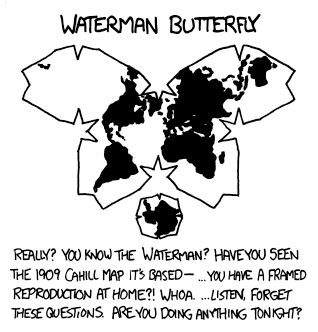

Schrödinger was not “rejecting” quantum mechanics, he was rejecting people treating things described in a superposition of states as literally existing in “two places at once.” And Schrödinger’s argument still holds up perfectly. What you are doing is equating a very dubious philosophical take on quantum mechanics with quantum mechanics itself, as if anyone who does not adhere to this dubious philosophical take is “denying quantum mechanics.” But this was not what Schrödinger was doing at all.
What you say here is a popular opinion, but it just doesn’t make any sense if you apply any scrutiny to it, which is what Schrödinger was trying to show. Quantum mechanics is a statistical theory where probability amplitudes are complex-valued, so things can have a -100% chance of occurring, or even a 100i% chance of occurring. This gives rise to interference effects which are unique to quantum mechanics. You interpret what these probabilities mean in physical reality based on how far they are away from zero (the further from zero, the more probable), but the negative signs allow for things to cancel out in ways that would not occur in normal probability theory, known as interference effects. Interference effects are the hallmark of quantum mechanics.
Because quantum probabilities have this difference, some people have wondered if maybe they are not probabilities at all but describe some sort of physical entity. If you believe this, then when you describe a particle as having a 50% probability of being here and a 50% probability of being there, then this is not just a statistical prediction but there must be some sort of “smeared out” entity that is both here and there simultaneously. Schrödinger showed that believing this leads to nonsense as you could trivially set up a chain reaction that scales up the effect of a single particle in a superposition of states to eventually affect a big system, forcing you to describe the big system, like a cat, in a superposition of states. If you believe particles really are “smeared out” here and there simultaneously, then you have to believe cats can be both “smeared out” here and there simultaneously.
Ironically, it was Schrödinger himself that spawned this way of thinking. Quantum mechanics was originally formulated without superposition in what is known as matrix mechanics. Matrix mechanics is complete, meaning, it fully makes all the same predictions as traditional quantum mechanics. It is a mathematically equivalent theory. Yet, what is different about it is that it does not include any sort of continuous evolution of a quantum state. It only describes discrete observables and how they change when they undergo discrete interactions.
Schrödinger did not like this on philosophical grounds due to the lack of continuity. There were discrete “gaps” between interactions. He criticized it saying that “I do not believe that the electron hops about like a flea” and came up with his famous wave equation as a replacement. This wave equation describes a list of probability amplitudes evolving like a wave in between interactions, and makes the same predictions as matrix mechanics. People then use the wave equation to argue that the particle literally becomes smeared out like a wave in between interactions.
However, Schrödinger later abandoned this point of view because it leads to nonsense. He pointed in one of his books that while his wave equation gets rid of the gaps in between interactions, it introduces a new gap in between the wave and the particle, as the moment you measure the wave it “jumps” into being a particle randomly, which is sometimes called the “collapse of the wave function.” This made even less sense because suddenly there is a special role for measurement. Take the cat example. Why doesn’t the cat’s observation of this wave not cause it to “collapse” but the person’s observation does? There is no special role for “measurement” in quantum mechanics, so it is unclear how to even answer this in the framework of quantum mechanics.
Schrödinger was thus arguing to go back to the position of treating quantum mechanics as a theory of discrete interactions. There are just “gaps” between interactions we cannot fill. The probability distribution does not represent a literal physical entity, it is just a predictive tool, a list of probabilities assigned to predict the outcome of an experiment. If we say a particle has a 50% chance of being here or a 50% chance of being there, it is just a prediction of where it will be if we were to measure it and shouldn’t be interpreted as the particle being literally smeared out between here and there at the same time.
There is no reason you have to actually believe particles can be smeared out between here and there at the same time. This is a philosophical interpretation which, if you believe it, it has an enormous amount of problems with it, such as what Schrödinger pointed out which ultimately gets to the heart of the measurement problem, but there are even larger problems. Wigner had also pointed out a paradox whereby two observers would assign different probability distributions to the same system. If it is merely probabilities, this isn’t a problem. If I flip a coin and look at the outcome and it’s heads, I would say it has a 100% chance of being heads because I saw it as heads, but if I asked you and covered it up so you did not see it, you would assign a 50% probability of it being heads or tails. If you believe the wave function represents a physical entity, then you could setup something similar in quantum mechanics whereby two different observers would describe two different waves, and so the physical shape of the wave would have to differ based on the observer.
There are a lot more problems as well. A probability distribution scales up in terms of its dimensions exponentially. With a single bit, there are two possible outcomes, 0 and 1. With two bits, there’s four possible outcomes, 00, 01, 10, and 11. With three bits, eight outcomes. With four bits, sixteen outcomes. If we assign a probability amplitude to each possible outcome, then the number of degrees of freedom grows exponentially the more bits we have under consideration.
This is also true in quantum mechanics for the wave function, since it is again basically a list of probability amplitudes. If we treat the wave function as representing a physical wave, then this wave would not exist in our four-dimensional spacetime, but instead in an infinitely dimensional space known as a Hilbert space. If you want to believe the universe actually physically made up of infinitely dimensional waves, have at ya. But personally, I find it much easier to just treat a probability distribution as, well, a probability distribution.







I am factually correct, I am not here to “debate,” I am telling you how the theory works. When two systems interact such that they become statistically correlated with one another and knowing the state of one tells you the state of the other, it is no longer valid to assign a state vector to the system subsystems that are part of the interaction individually, you have to assign it to the system as a whole. When you do a partial trace on the system individually to get a reduced density matrix for the two systems, if they are perfectly entangled, then you end with a density matrix without coherence terms and thus without interference effects.
This is absolutely entanglement, this is what entanglement is. I am not misunderstanding what entanglement is, if you think what I have described here is not entanglement but a superposition of states then you don’t know what a superposition of states is. Yes, an entangled state would be in a superposition of states, but it would be a superposition of states which can only be applied to both correlated systems together and not to the individual subsystems.
Let’s say R = 1/sqrt(2) and Alice sends Bob a qubit. If the qubit has a probability of 1 of being the value 1 and Alice applies the Hadamard gate, it changes to R probability of being 0 and -R probability of being 1. In this state, if Bob were to apply a second Hadamard gate, then it undoes the first Hadamard gate and so it would have a probability of 1 of being a value of 1 due to interference effects.
However, if an eavesdropper, let’s call them Eve, measures the qubit in transit, because R and -R are equal distances from the origin, it would have an equal chance of being 0 or 1. Let’s say it’s 1. From their point of view, they would then update their probability distribution to be a probability of 1 of being the value 1 and send it off to Bob. When Bob applies the second Hadamard gate, it would then have a probability of R for being 0 and a probability of -R for being 1, and thus what should’ve been deterministic is now random noise for Bob.
Yet, this description only works from Eve’s point of view. From Alice and Bob’s point of view, neither of them measured the particle in transit, so when Bob received it, it still is probabilistic with an equal chance of being 0 and 1. So why does Bob still predict that interference effects will be lost if it is still probabilistic for him?
Because when Eve interacts with the qubit, from Alice and Bob’s perspective, it is no longer valid to assign a state vector to the qubit on its own. Eve and the qubit become correlated with one another. For Eve to know the particle’s state, there has to be some correlation between something in Eve’s brain (or, more directly, her measuring device) and the state of the particle. They are thus entangled with one another and Alice and Bob would have to assign the state vector to Eve and the qubit taken together and not to the individual parts.
Eve and the qubit taken together would have a probability distribution of R for the qubit being 0 and Eve knowing the qubit is 0, and a probability of -R of the qubit being 1 and Eve knowing the qubit is 1. There is still interference effects but only of the whole system taken together. Yet, Bob does not receive Eve and the qubit taken together. He receives only the qubit, so this probability distribution is no longer applicable to the qubit.
He instead has to do a partial trace to trace out (ignore) Eve from the equation to know how his qubit alone would behave. When he does this, he finds that the probability distribution has changed to 0.5 for 0 and 0.5 for 1. In the density matrix representation, you will see that the density matrix has all zeroes for the coherences. This is a classical probability distribution, something that cannot exhibit interference effects.
Bob simply cannot explain why his qubit loses its interference effects by Eve measuring it without Bob taking into account entanglement, at least within the framework of quantum theory. That is just how the theory works. The explanation from Eve’s perspective simply does not work for Bob in quantum mechanics. Reducing the state vector simultaneously between two different perspectives is known as an objective collapse model and makes different statistical predictions than quantum mechanics. It would not merely be an alternative interpretation but an alternative theory.
Eve explains the loss of coherence due to her reducing the state vector due to seeing a definite outcome for the qubit, and Bob explains the loss of coherence due to Eve becoming entangled with the qubit which leads to decoherence as doing a partial trace to trace out (ignore) Eve gives a reduced density matrix for the qubit whereby the coherence terms are zero.